Leadership and Management for Service Industries: A Detailed Report
VerifiedAdded on 2020/10/23
|11
|2422
|409
Report
AI Summary
This report provides a comprehensive analysis of leadership and management principles within the service industry, using the case of Docklands Academy and the restaurant chains Hazev, Haz, and Tas as examples. It begins by exploring classical management theories and their application to the service sector, including behavioral and administrative theories. The report then delves into various leadership styles, such as authoritarian, consensual, and hands-off approaches, and their impact on service quality and employee motivation. Furthermore, it examines the influence of both internal and external factors, including political, economic, social, and technological factors, on management styles and organizational structure. The report concludes by highlighting the importance of adapting leadership and management practices to improve performance and brand image, emphasizing the role of digital marketing and technological advancements. The report also includes an analysis of the strengths, weaknesses, opportunities, and threats (SWOT) associated with the case study companies.
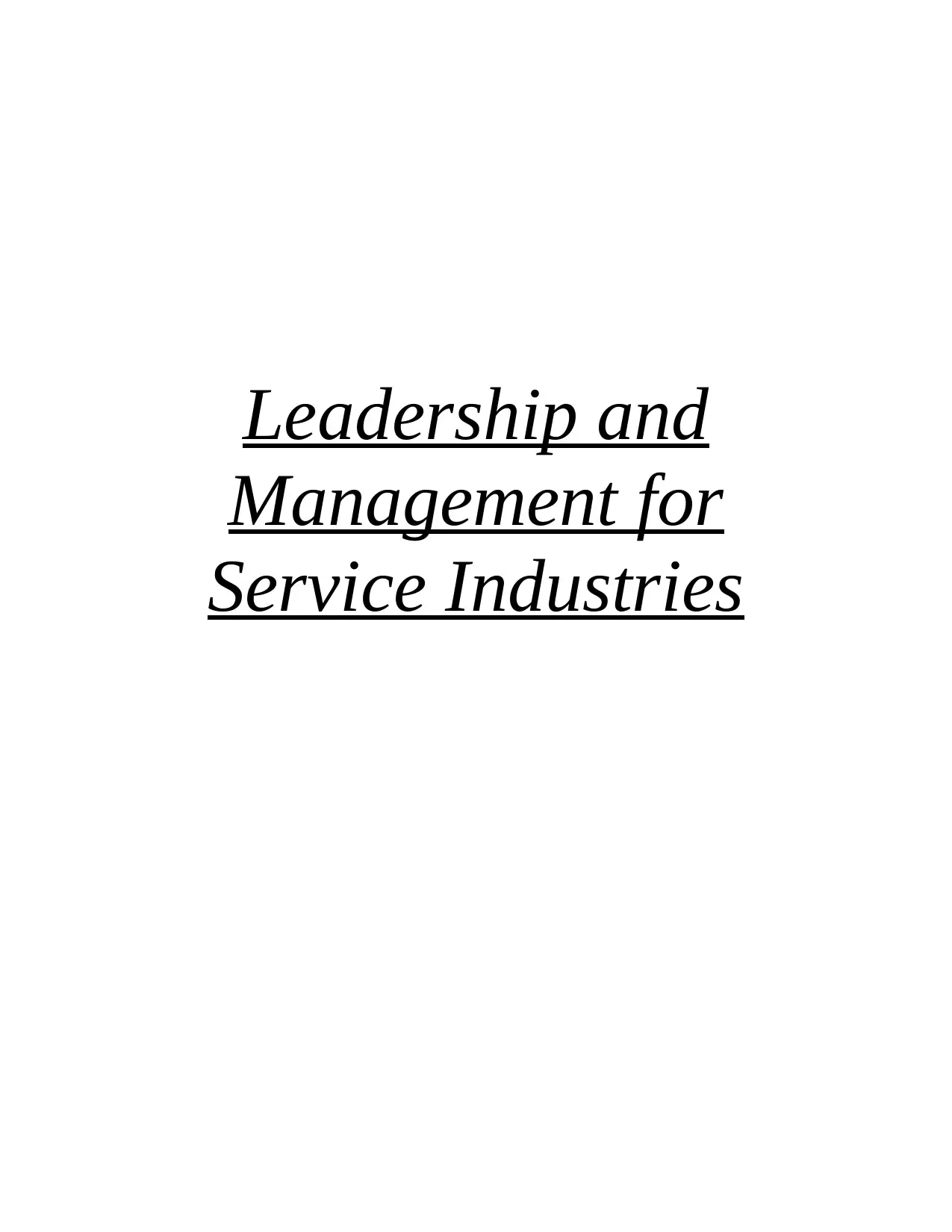
Leadership and
Management for
Service Industries
Management for
Service Industries
Paraphrase This Document
Need a fresh take? Get an instant paraphrase of this document with our AI Paraphraser
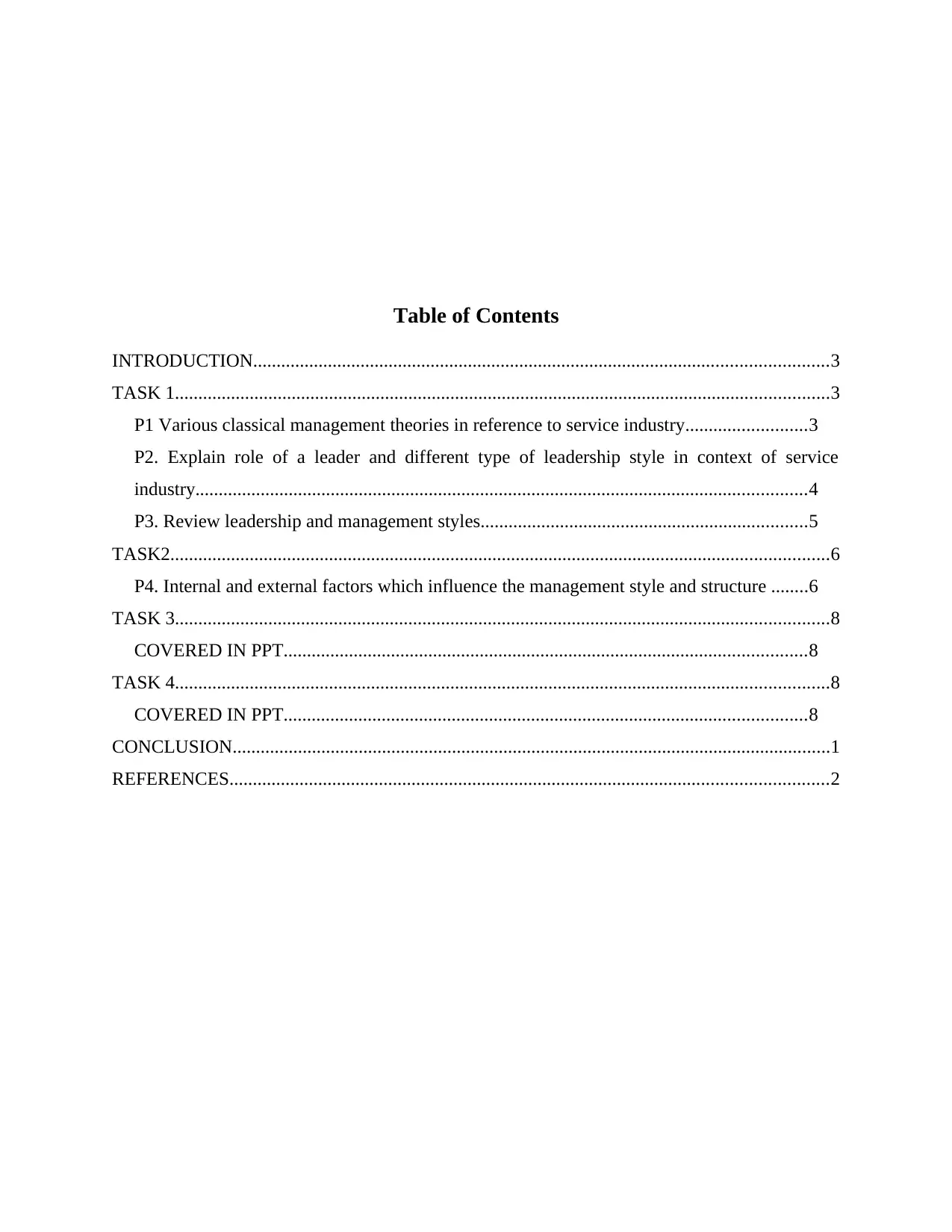
Table of Contents
INTRODUCTION...........................................................................................................................3
TASK 1............................................................................................................................................3
P1 Various classical management theories in reference to service industry..........................3
P2. Explain role of a leader and different type of leadership style in context of service
industry...................................................................................................................................4
P3. Review leadership and management styles......................................................................5
TASK2.............................................................................................................................................6
P4. Internal and external factors which influence the management style and structure ........6
TASK 3............................................................................................................................................8
COVERED IN PPT................................................................................................................8
TASK 4............................................................................................................................................8
COVERED IN PPT................................................................................................................8
CONCLUSION................................................................................................................................1
REFERENCES................................................................................................................................2
INTRODUCTION...........................................................................................................................3
TASK 1............................................................................................................................................3
P1 Various classical management theories in reference to service industry..........................3
P2. Explain role of a leader and different type of leadership style in context of service
industry...................................................................................................................................4
P3. Review leadership and management styles......................................................................5
TASK2.............................................................................................................................................6
P4. Internal and external factors which influence the management style and structure ........6
TASK 3............................................................................................................................................8
COVERED IN PPT................................................................................................................8
TASK 4............................................................................................................................................8
COVERED IN PPT................................................................................................................8
CONCLUSION................................................................................................................................1
REFERENCES................................................................................................................................2
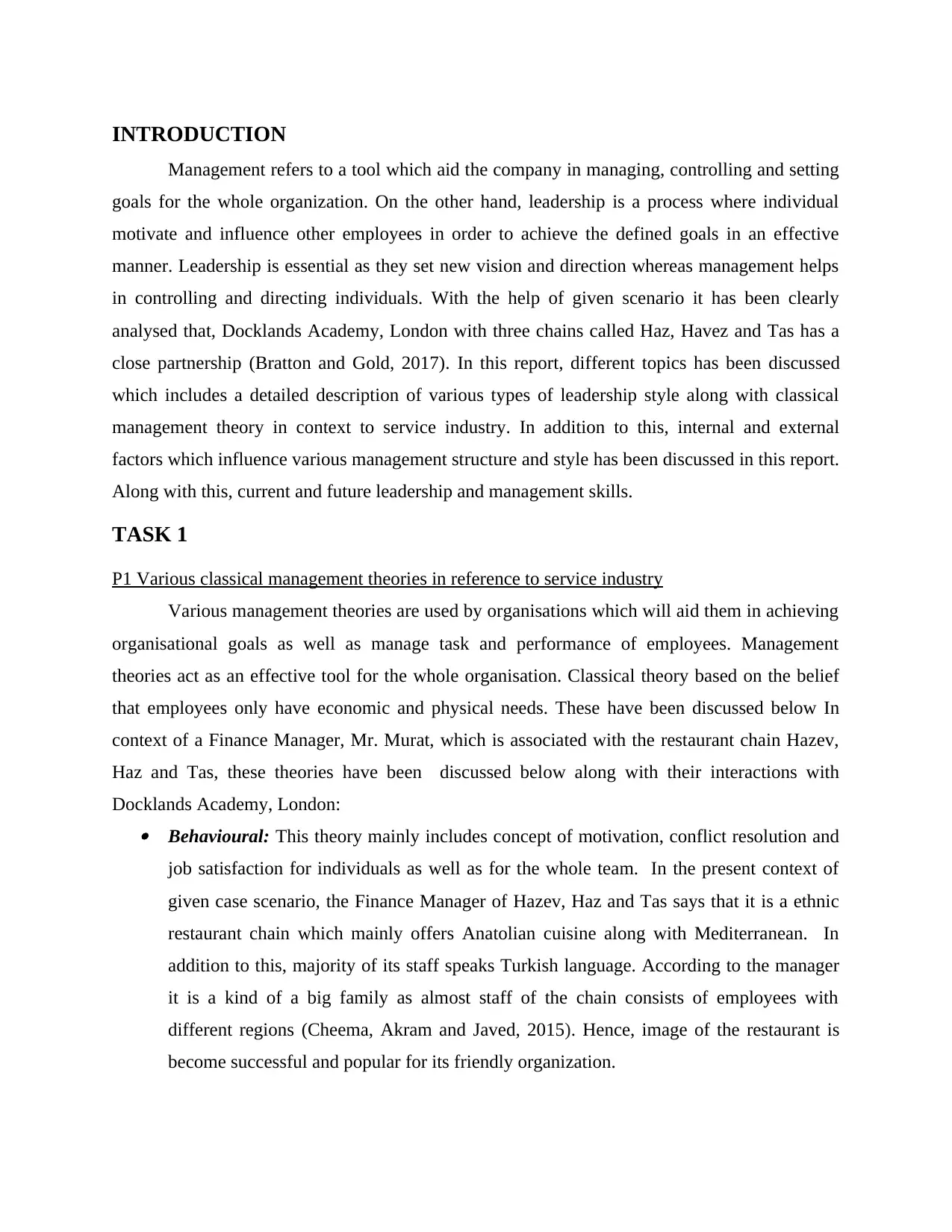
INTRODUCTION
Management refers to a tool which aid the company in managing, controlling and setting
goals for the whole organization. On the other hand, leadership is a process where individual
motivate and influence other employees in order to achieve the defined goals in an effective
manner. Leadership is essential as they set new vision and direction whereas management helps
in controlling and directing individuals. With the help of given scenario it has been clearly
analysed that, Docklands Academy, London with three chains called Haz, Havez and Tas has a
close partnership (Bratton and Gold, 2017). In this report, different topics has been discussed
which includes a detailed description of various types of leadership style along with classical
management theory in context to service industry. In addition to this, internal and external
factors which influence various management structure and style has been discussed in this report.
Along with this, current and future leadership and management skills.
TASK 1
P1 Various classical management theories in reference to service industry
Various management theories are used by organisations which will aid them in achieving
organisational goals as well as manage task and performance of employees. Management
theories act as an effective tool for the whole organisation. Classical theory based on the belief
that employees only have economic and physical needs. These have been discussed below In
context of a Finance Manager, Mr. Murat, which is associated with the restaurant chain Hazev,
Haz and Tas, these theories have been discussed below along with their interactions with
Docklands Academy, London: Behavioural: This theory mainly includes concept of motivation, conflict resolution and
job satisfaction for individuals as well as for the whole team. In the present context of
given case scenario, the Finance Manager of Hazev, Haz and Tas says that it is a ethnic
restaurant chain which mainly offers Anatolian cuisine along with Mediterranean. In
addition to this, majority of its staff speaks Turkish language. According to the manager
it is a kind of a big family as almost staff of the chain consists of employees with
different regions (Cheema, Akram and Javed, 2015). Hence, image of the restaurant is
become successful and popular for its friendly organization.
Management refers to a tool which aid the company in managing, controlling and setting
goals for the whole organization. On the other hand, leadership is a process where individual
motivate and influence other employees in order to achieve the defined goals in an effective
manner. Leadership is essential as they set new vision and direction whereas management helps
in controlling and directing individuals. With the help of given scenario it has been clearly
analysed that, Docklands Academy, London with three chains called Haz, Havez and Tas has a
close partnership (Bratton and Gold, 2017). In this report, different topics has been discussed
which includes a detailed description of various types of leadership style along with classical
management theory in context to service industry. In addition to this, internal and external
factors which influence various management structure and style has been discussed in this report.
Along with this, current and future leadership and management skills.
TASK 1
P1 Various classical management theories in reference to service industry
Various management theories are used by organisations which will aid them in achieving
organisational goals as well as manage task and performance of employees. Management
theories act as an effective tool for the whole organisation. Classical theory based on the belief
that employees only have economic and physical needs. These have been discussed below In
context of a Finance Manager, Mr. Murat, which is associated with the restaurant chain Hazev,
Haz and Tas, these theories have been discussed below along with their interactions with
Docklands Academy, London: Behavioural: This theory mainly includes concept of motivation, conflict resolution and
job satisfaction for individuals as well as for the whole team. In the present context of
given case scenario, the Finance Manager of Hazev, Haz and Tas says that it is a ethnic
restaurant chain which mainly offers Anatolian cuisine along with Mediterranean. In
addition to this, majority of its staff speaks Turkish language. According to the manager
it is a kind of a big family as almost staff of the chain consists of employees with
different regions (Cheema, Akram and Javed, 2015). Hence, image of the restaurant is
become successful and popular for its friendly organization.
⊘ This is a preview!⊘
Do you want full access?
Subscribe today to unlock all pages.

Trusted by 1+ million students worldwide
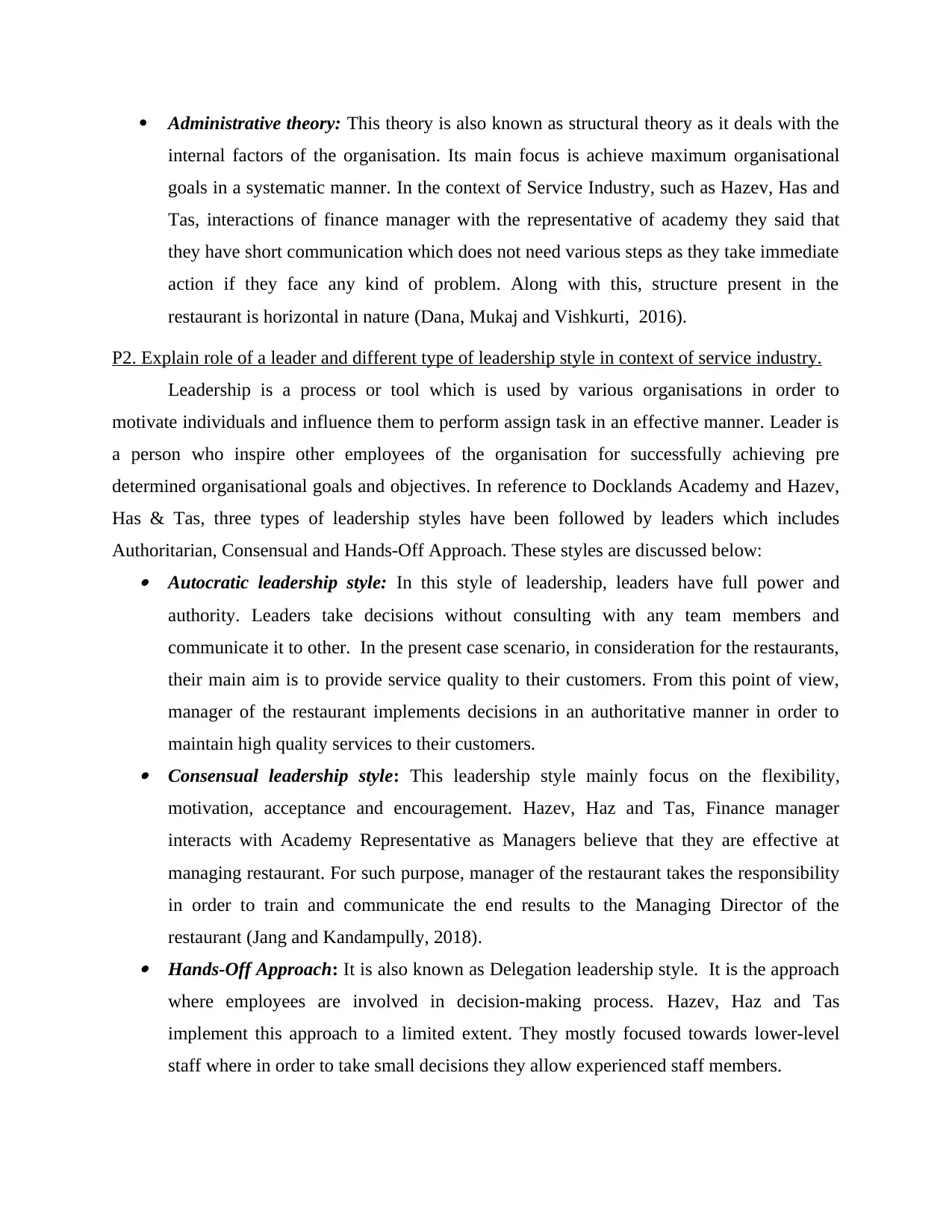
Administrative theory: This theory is also known as structural theory as it deals with the
internal factors of the organisation. Its main focus is achieve maximum organisational
goals in a systematic manner. In the context of Service Industry, such as Hazev, Has and
Tas, interactions of finance manager with the representative of academy they said that
they have short communication which does not need various steps as they take immediate
action if they face any kind of problem. Along with this, structure present in the
restaurant is horizontal in nature (Dana, Mukaj and Vishkurti, 2016).
P2. Explain role of a leader and different type of leadership style in context of service industry.
Leadership is a process or tool which is used by various organisations in order to
motivate individuals and influence them to perform assign task in an effective manner. Leader is
a person who inspire other employees of the organisation for successfully achieving pre
determined organisational goals and objectives. In reference to Docklands Academy and Hazev,
Has & Tas, three types of leadership styles have been followed by leaders which includes
Authoritarian, Consensual and Hands-Off Approach. These styles are discussed below: Autocratic leadership style: In this style of leadership, leaders have full power and
authority. Leaders take decisions without consulting with any team members and
communicate it to other. In the present case scenario, in consideration for the restaurants,
their main aim is to provide service quality to their customers. From this point of view,
manager of the restaurant implements decisions in an authoritative manner in order to
maintain high quality services to their customers. Consensual leadership style: This leadership style mainly focus on the flexibility,
motivation, acceptance and encouragement. Hazev, Haz and Tas, Finance manager
interacts with Academy Representative as Managers believe that they are effective at
managing restaurant. For such purpose, manager of the restaurant takes the responsibility
in order to train and communicate the end results to the Managing Director of the
restaurant (Jang and Kandampully, 2018). Hands-Off Approach: It is also known as Delegation leadership style. It is the approach
where employees are involved in decision-making process. Hazev, Haz and Tas
implement this approach to a limited extent. They mostly focused towards lower-level
staff where in order to take small decisions they allow experienced staff members.
internal factors of the organisation. Its main focus is achieve maximum organisational
goals in a systematic manner. In the context of Service Industry, such as Hazev, Has and
Tas, interactions of finance manager with the representative of academy they said that
they have short communication which does not need various steps as they take immediate
action if they face any kind of problem. Along with this, structure present in the
restaurant is horizontal in nature (Dana, Mukaj and Vishkurti, 2016).
P2. Explain role of a leader and different type of leadership style in context of service industry.
Leadership is a process or tool which is used by various organisations in order to
motivate individuals and influence them to perform assign task in an effective manner. Leader is
a person who inspire other employees of the organisation for successfully achieving pre
determined organisational goals and objectives. In reference to Docklands Academy and Hazev,
Has & Tas, three types of leadership styles have been followed by leaders which includes
Authoritarian, Consensual and Hands-Off Approach. These styles are discussed below: Autocratic leadership style: In this style of leadership, leaders have full power and
authority. Leaders take decisions without consulting with any team members and
communicate it to other. In the present case scenario, in consideration for the restaurants,
their main aim is to provide service quality to their customers. From this point of view,
manager of the restaurant implements decisions in an authoritative manner in order to
maintain high quality services to their customers. Consensual leadership style: This leadership style mainly focus on the flexibility,
motivation, acceptance and encouragement. Hazev, Haz and Tas, Finance manager
interacts with Academy Representative as Managers believe that they are effective at
managing restaurant. For such purpose, manager of the restaurant takes the responsibility
in order to train and communicate the end results to the Managing Director of the
restaurant (Jang and Kandampully, 2018). Hands-Off Approach: It is also known as Delegation leadership style. It is the approach
where employees are involved in decision-making process. Hazev, Haz and Tas
implement this approach to a limited extent. They mostly focused towards lower-level
staff where in order to take small decisions they allow experienced staff members.
Paraphrase This Document
Need a fresh take? Get an instant paraphrase of this document with our AI Paraphraser
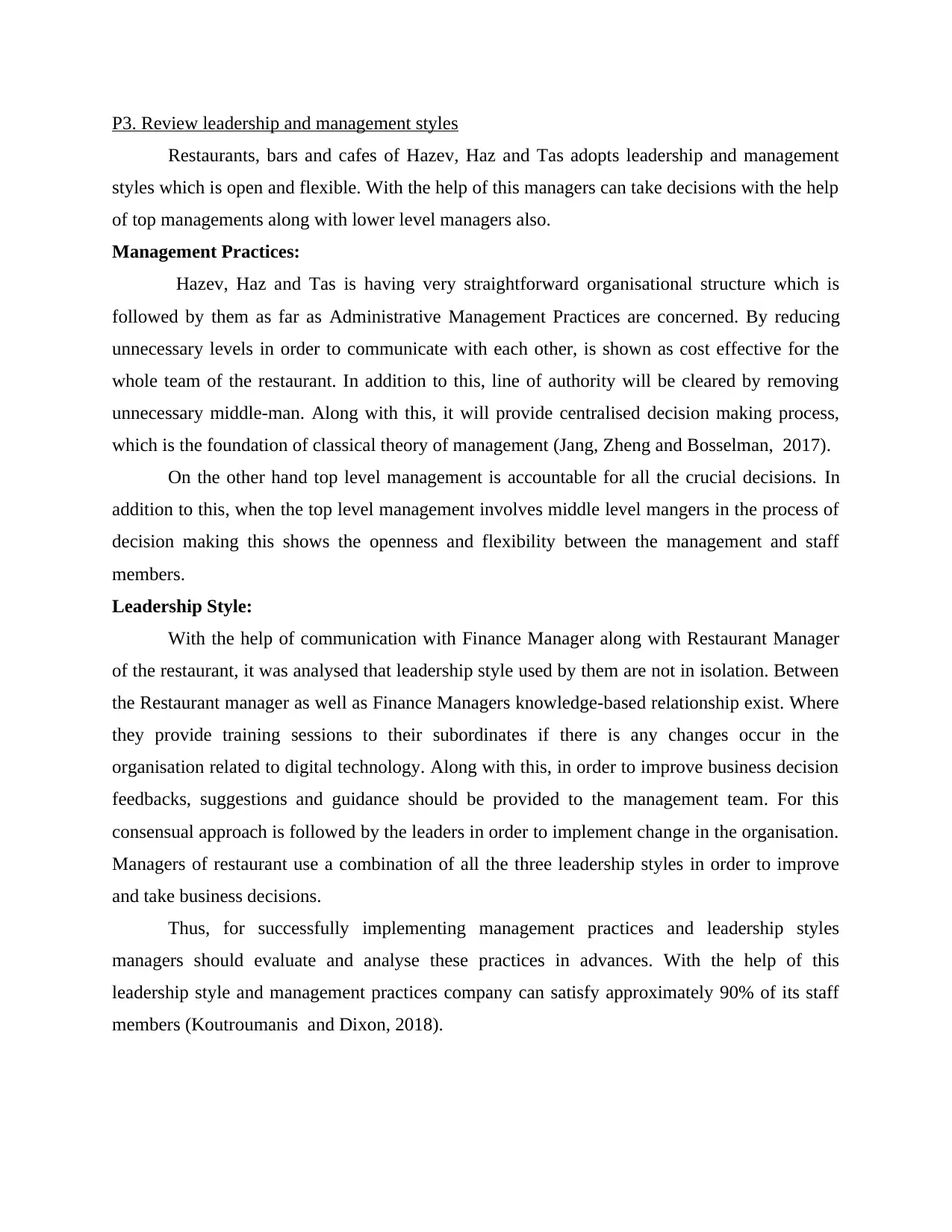
P3. Review leadership and management styles
Restaurants, bars and cafes of Hazev, Haz and Tas adopts leadership and management
styles which is open and flexible. With the help of this managers can take decisions with the help
of top managements along with lower level managers also.
Management Practices:
Hazev, Haz and Tas is having very straightforward organisational structure which is
followed by them as far as Administrative Management Practices are concerned. By reducing
unnecessary levels in order to communicate with each other, is shown as cost effective for the
whole team of the restaurant. In addition to this, line of authority will be cleared by removing
unnecessary middle-man. Along with this, it will provide centralised decision making process,
which is the foundation of classical theory of management (Jang, Zheng and Bosselman, 2017).
On the other hand top level management is accountable for all the crucial decisions. In
addition to this, when the top level management involves middle level mangers in the process of
decision making this shows the openness and flexibility between the management and staff
members.
Leadership Style:
With the help of communication with Finance Manager along with Restaurant Manager
of the restaurant, it was analysed that leadership style used by them are not in isolation. Between
the Restaurant manager as well as Finance Managers knowledge-based relationship exist. Where
they provide training sessions to their subordinates if there is any changes occur in the
organisation related to digital technology. Along with this, in order to improve business decision
feedbacks, suggestions and guidance should be provided to the management team. For this
consensual approach is followed by the leaders in order to implement change in the organisation.
Managers of restaurant use a combination of all the three leadership styles in order to improve
and take business decisions.
Thus, for successfully implementing management practices and leadership styles
managers should evaluate and analyse these practices in advances. With the help of this
leadership style and management practices company can satisfy approximately 90% of its staff
members (Koutroumanis and Dixon, 2018).
Restaurants, bars and cafes of Hazev, Haz and Tas adopts leadership and management
styles which is open and flexible. With the help of this managers can take decisions with the help
of top managements along with lower level managers also.
Management Practices:
Hazev, Haz and Tas is having very straightforward organisational structure which is
followed by them as far as Administrative Management Practices are concerned. By reducing
unnecessary levels in order to communicate with each other, is shown as cost effective for the
whole team of the restaurant. In addition to this, line of authority will be cleared by removing
unnecessary middle-man. Along with this, it will provide centralised decision making process,
which is the foundation of classical theory of management (Jang, Zheng and Bosselman, 2017).
On the other hand top level management is accountable for all the crucial decisions. In
addition to this, when the top level management involves middle level mangers in the process of
decision making this shows the openness and flexibility between the management and staff
members.
Leadership Style:
With the help of communication with Finance Manager along with Restaurant Manager
of the restaurant, it was analysed that leadership style used by them are not in isolation. Between
the Restaurant manager as well as Finance Managers knowledge-based relationship exist. Where
they provide training sessions to their subordinates if there is any changes occur in the
organisation related to digital technology. Along with this, in order to improve business decision
feedbacks, suggestions and guidance should be provided to the management team. For this
consensual approach is followed by the leaders in order to implement change in the organisation.
Managers of restaurant use a combination of all the three leadership styles in order to improve
and take business decisions.
Thus, for successfully implementing management practices and leadership styles
managers should evaluate and analyse these practices in advances. With the help of this
leadership style and management practices company can satisfy approximately 90% of its staff
members (Koutroumanis and Dixon, 2018).

TASK2
P4. Internal and external factors which influence the management style and structure
There are various internal as well as external factors which influence the structure as well
as style of management used by managers of the company. Different external and internal factors
are as follows:
External factors:
External factors refers to those which is conducted outside the business organisation but
affects the overall working structure of the company. There are various external elements which
directly affects the management style of the company. These factors are political, economical,
social and technological factors (Nieves and Segarra-Ciprés, 2015). Political factors: Under this factor, all the rules and regulations decided by the
government of the country should be followed by the organisation. In the given case
study, managers of the company is abide to follow all the tax rates, tariffs and many other
policies applied by the government. If there is any change in the tax rates, it directly
affects the management structure of the company. Economical factors: Economic situation greatly influence the business operations as it
includes exchange rates, inflation rates and many more. In the given case study, if there is
any changes occur in the labour cost it will affect the production cost of the company. As
a result change in any external factor affect the working structure of the company. Social factors: Under the social factor, various elements are included which is income
level, consumers taste, preference and many more. Now a days, people are more health
conscious and prefer low fat and healthy food products. This factors affects the overall
structure and style of the organisation. Managers of the restaurant should provide healthy
and good quality products for maintaining long term healthy relationship with their
customers (Payne-Palacio, 2016). Technological factors: With the continuous change in technology, management style
and structure of the restaurant affects in a negative way. For avoiding such situations
managers of the company should adopt latest technology and produce high quality
products and services.
Internal factors:
P4. Internal and external factors which influence the management style and structure
There are various internal as well as external factors which influence the structure as well
as style of management used by managers of the company. Different external and internal factors
are as follows:
External factors:
External factors refers to those which is conducted outside the business organisation but
affects the overall working structure of the company. There are various external elements which
directly affects the management style of the company. These factors are political, economical,
social and technological factors (Nieves and Segarra-Ciprés, 2015). Political factors: Under this factor, all the rules and regulations decided by the
government of the country should be followed by the organisation. In the given case
study, managers of the company is abide to follow all the tax rates, tariffs and many other
policies applied by the government. If there is any change in the tax rates, it directly
affects the management structure of the company. Economical factors: Economic situation greatly influence the business operations as it
includes exchange rates, inflation rates and many more. In the given case study, if there is
any changes occur in the labour cost it will affect the production cost of the company. As
a result change in any external factor affect the working structure of the company. Social factors: Under the social factor, various elements are included which is income
level, consumers taste, preference and many more. Now a days, people are more health
conscious and prefer low fat and healthy food products. This factors affects the overall
structure and style of the organisation. Managers of the restaurant should provide healthy
and good quality products for maintaining long term healthy relationship with their
customers (Payne-Palacio, 2016). Technological factors: With the continuous change in technology, management style
and structure of the restaurant affects in a negative way. For avoiding such situations
managers of the company should adopt latest technology and produce high quality
products and services.
Internal factors:
⊘ This is a preview!⊘
Do you want full access?
Subscribe today to unlock all pages.

Trusted by 1+ million students worldwide
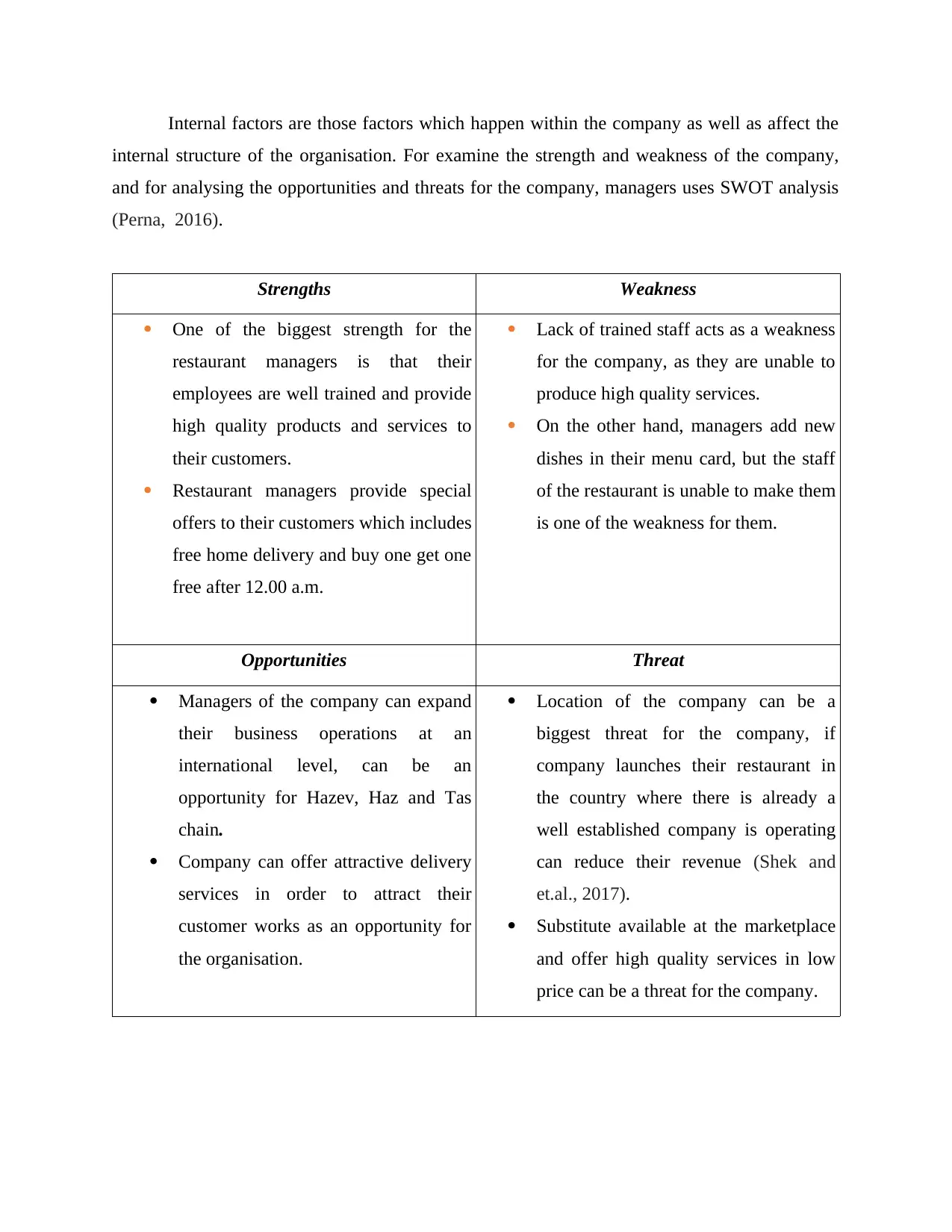
Internal factors are those factors which happen within the company as well as affect the
internal structure of the organisation. For examine the strength and weakness of the company,
and for analysing the opportunities and threats for the company, managers uses SWOT analysis
(Perna, 2016).
Strengths Weakness
One of the biggest strength for the
restaurant managers is that their
employees are well trained and provide
high quality products and services to
their customers.
Restaurant managers provide special
offers to their customers which includes
free home delivery and buy one get one
free after 12.00 a.m.
Lack of trained staff acts as a weakness
for the company, as they are unable to
produce high quality services.
On the other hand, managers add new
dishes in their menu card, but the staff
of the restaurant is unable to make them
is one of the weakness for them.
Opportunities Threat
Managers of the company can expand
their business operations at an
international level, can be an
opportunity for Hazev, Haz and Tas
chain.
Company can offer attractive delivery
services in order to attract their
customer works as an opportunity for
the organisation.
Location of the company can be a
biggest threat for the company, if
company launches their restaurant in
the country where there is already a
well established company is operating
can reduce their revenue (Shek and
et.al., 2017).
Substitute available at the marketplace
and offer high quality services in low
price can be a threat for the company.
internal structure of the organisation. For examine the strength and weakness of the company,
and for analysing the opportunities and threats for the company, managers uses SWOT analysis
(Perna, 2016).
Strengths Weakness
One of the biggest strength for the
restaurant managers is that their
employees are well trained and provide
high quality products and services to
their customers.
Restaurant managers provide special
offers to their customers which includes
free home delivery and buy one get one
free after 12.00 a.m.
Lack of trained staff acts as a weakness
for the company, as they are unable to
produce high quality services.
On the other hand, managers add new
dishes in their menu card, but the staff
of the restaurant is unable to make them
is one of the weakness for them.
Opportunities Threat
Managers of the company can expand
their business operations at an
international level, can be an
opportunity for Hazev, Haz and Tas
chain.
Company can offer attractive delivery
services in order to attract their
customer works as an opportunity for
the organisation.
Location of the company can be a
biggest threat for the company, if
company launches their restaurant in
the country where there is already a
well established company is operating
can reduce their revenue (Shek and
et.al., 2017).
Substitute available at the marketplace
and offer high quality services in low
price can be a threat for the company.
Paraphrase This Document
Need a fresh take? Get an instant paraphrase of this document with our AI Paraphraser

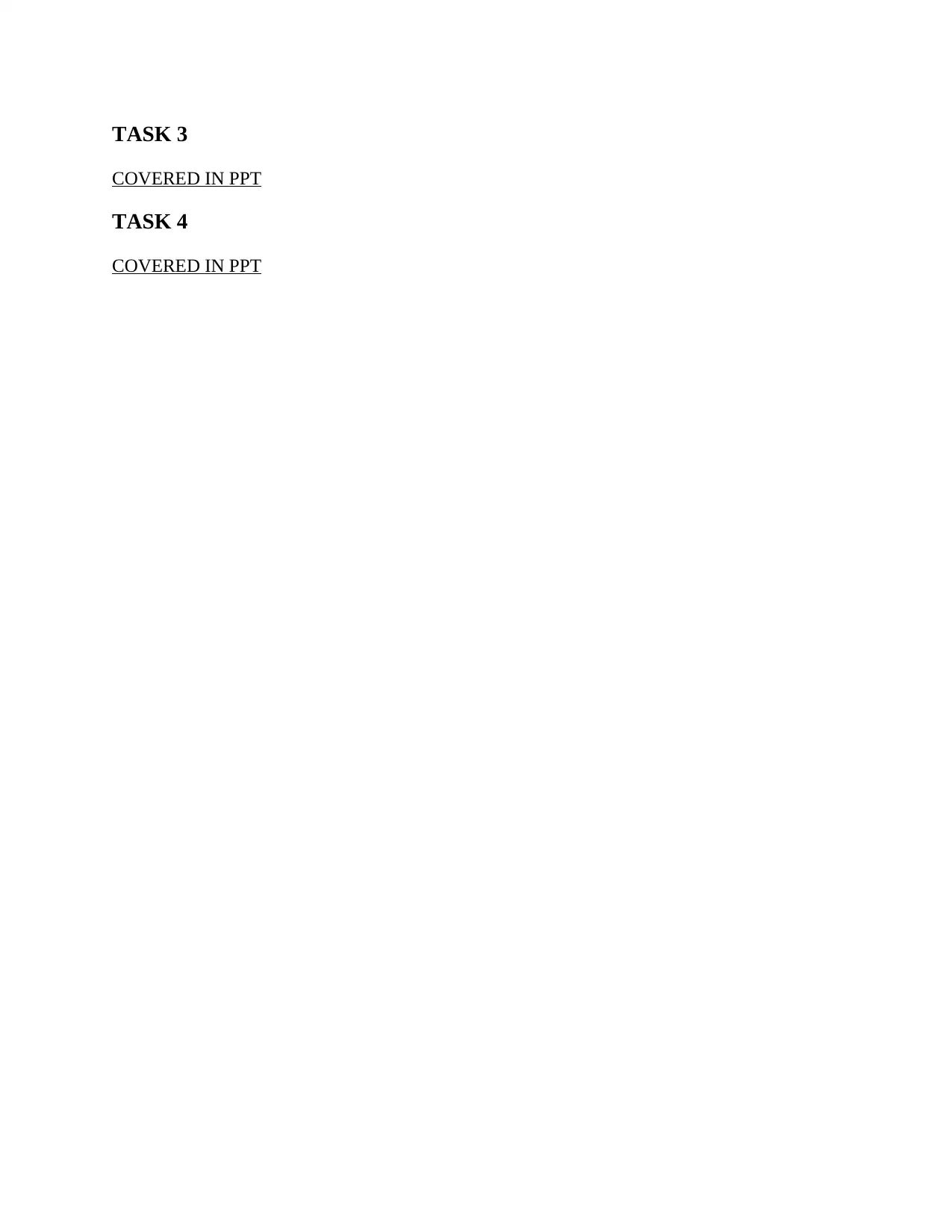
TASK 3
COVERED IN PPT
TASK 4
COVERED IN PPT
COVERED IN PPT
TASK 4
COVERED IN PPT
⊘ This is a preview!⊘
Do you want full access?
Subscribe today to unlock all pages.

Trusted by 1+ million students worldwide
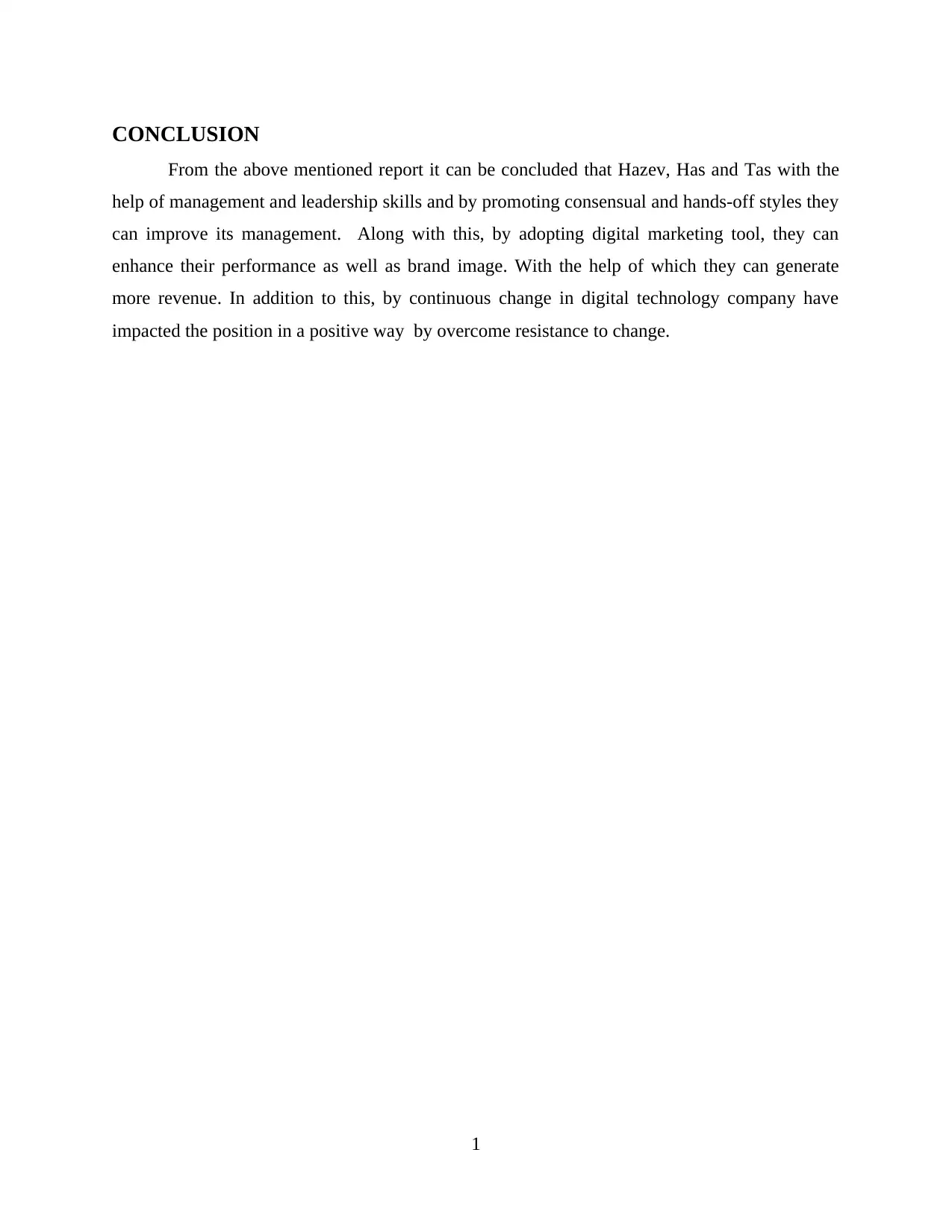
CONCLUSION
From the above mentioned report it can be concluded that Hazev, Has and Tas with the
help of management and leadership skills and by promoting consensual and hands-off styles they
can improve its management. Along with this, by adopting digital marketing tool, they can
enhance their performance as well as brand image. With the help of which they can generate
more revenue. In addition to this, by continuous change in digital technology company have
impacted the position in a positive way by overcome resistance to change.
1
From the above mentioned report it can be concluded that Hazev, Has and Tas with the
help of management and leadership skills and by promoting consensual and hands-off styles they
can improve its management. Along with this, by adopting digital marketing tool, they can
enhance their performance as well as brand image. With the help of which they can generate
more revenue. In addition to this, by continuous change in digital technology company have
impacted the position in a positive way by overcome resistance to change.
1
Paraphrase This Document
Need a fresh take? Get an instant paraphrase of this document with our AI Paraphraser
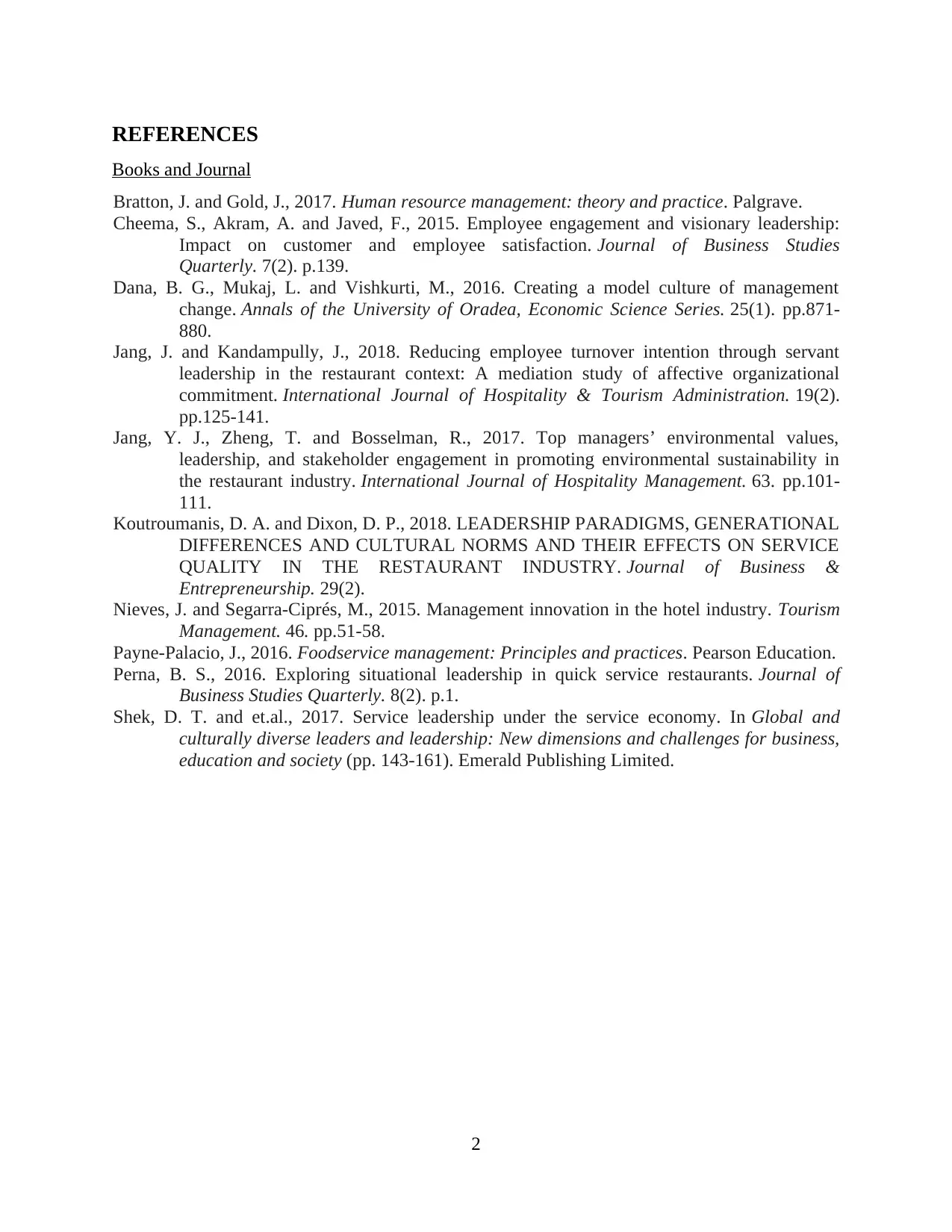
REFERENCES
Books and Journal
Bratton, J. and Gold, J., 2017. Human resource management: theory and practice. Palgrave.
Cheema, S., Akram, A. and Javed, F., 2015. Employee engagement and visionary leadership:
Impact on customer and employee satisfaction. Journal of Business Studies
Quarterly. 7(2). p.139.
Dana, B. G., Mukaj, L. and Vishkurti, M., 2016. Creating a model culture of management
change. Annals of the University of Oradea, Economic Science Series. 25(1). pp.871-
880.
Jang, J. and Kandampully, J., 2018. Reducing employee turnover intention through servant
leadership in the restaurant context: A mediation study of affective organizational
commitment. International Journal of Hospitality & Tourism Administration. 19(2).
pp.125-141.
Jang, Y. J., Zheng, T. and Bosselman, R., 2017. Top managers’ environmental values,
leadership, and stakeholder engagement in promoting environmental sustainability in
the restaurant industry. International Journal of Hospitality Management. 63. pp.101-
111.
Koutroumanis, D. A. and Dixon, D. P., 2018. LEADERSHIP PARADIGMS, GENERATIONAL
DIFFERENCES AND CULTURAL NORMS AND THEIR EFFECTS ON SERVICE
QUALITY IN THE RESTAURANT INDUSTRY. Journal of Business &
Entrepreneurship. 29(2).
Nieves, J. and Segarra-Ciprés, M., 2015. Management innovation in the hotel industry. Tourism
Management. 46. pp.51-58.
Payne-Palacio, J., 2016. Foodservice management: Principles and practices. Pearson Education.
Perna, B. S., 2016. Exploring situational leadership in quick service restaurants. Journal of
Business Studies Quarterly. 8(2). p.1.
Shek, D. T. and et.al., 2017. Service leadership under the service economy. In Global and
culturally diverse leaders and leadership: New dimensions and challenges for business,
education and society (pp. 143-161). Emerald Publishing Limited.
2
Books and Journal
Bratton, J. and Gold, J., 2017. Human resource management: theory and practice. Palgrave.
Cheema, S., Akram, A. and Javed, F., 2015. Employee engagement and visionary leadership:
Impact on customer and employee satisfaction. Journal of Business Studies
Quarterly. 7(2). p.139.
Dana, B. G., Mukaj, L. and Vishkurti, M., 2016. Creating a model culture of management
change. Annals of the University of Oradea, Economic Science Series. 25(1). pp.871-
880.
Jang, J. and Kandampully, J., 2018. Reducing employee turnover intention through servant
leadership in the restaurant context: A mediation study of affective organizational
commitment. International Journal of Hospitality & Tourism Administration. 19(2).
pp.125-141.
Jang, Y. J., Zheng, T. and Bosselman, R., 2017. Top managers’ environmental values,
leadership, and stakeholder engagement in promoting environmental sustainability in
the restaurant industry. International Journal of Hospitality Management. 63. pp.101-
111.
Koutroumanis, D. A. and Dixon, D. P., 2018. LEADERSHIP PARADIGMS, GENERATIONAL
DIFFERENCES AND CULTURAL NORMS AND THEIR EFFECTS ON SERVICE
QUALITY IN THE RESTAURANT INDUSTRY. Journal of Business &
Entrepreneurship. 29(2).
Nieves, J. and Segarra-Ciprés, M., 2015. Management innovation in the hotel industry. Tourism
Management. 46. pp.51-58.
Payne-Palacio, J., 2016. Foodservice management: Principles and practices. Pearson Education.
Perna, B. S., 2016. Exploring situational leadership in quick service restaurants. Journal of
Business Studies Quarterly. 8(2). p.1.
Shek, D. T. and et.al., 2017. Service leadership under the service economy. In Global and
culturally diverse leaders and leadership: New dimensions and challenges for business,
education and society (pp. 143-161). Emerald Publishing Limited.
2
1 out of 11
Related Documents
Your All-in-One AI-Powered Toolkit for Academic Success.
+13062052269
info@desklib.com
Available 24*7 on WhatsApp / Email
![[object Object]](/_next/static/media/star-bottom.7253800d.svg)
Unlock your academic potential
Copyright © 2020–2025 A2Z Services. All Rights Reserved. Developed and managed by ZUCOL.





